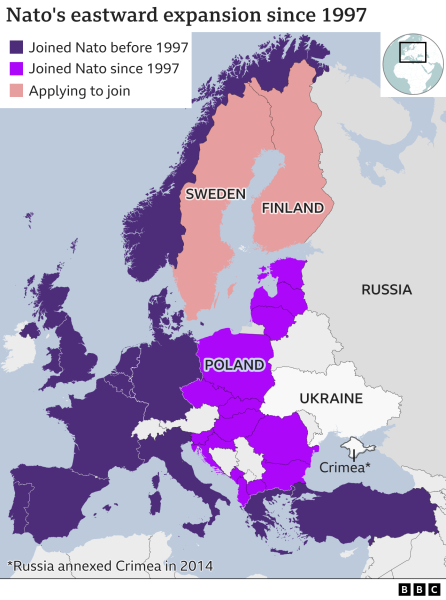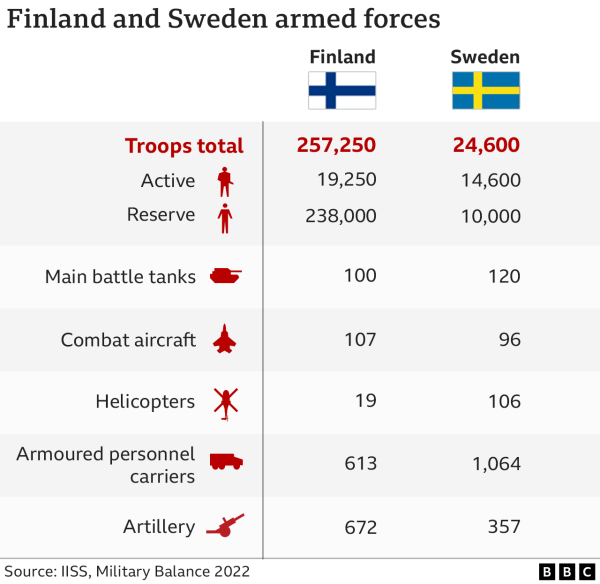

Image source, Getty Images
Countries from the Western defence alliance, Nato, have pledged air defence systems to Ukraine to help it defend its cities and towns against Russian attacks.
q0x1qg-Paragraph eq5iqo00″>President Volodymyr Zelensky says that currently, Ukraine only has enough surface-to-air missiles to defend 10% of the country.
What is Nato?
Nato – the North Atlantic Treaty Organization – is a defensive military alliance. It was formed in 1949 by 12 countries, including the US, UK, Canada and France.
Members agree to help one another if they come under armed attack.
Nato's original goal was to challenge Russian expansion in Europe after World War Two.
After the Soviet Union's collapse in 1991, many of the Eastern European countries which used to be Russia's allies in the Warsaw Pact were granted Nato membership.
Russia has long argued that Nato's acceptance of these countries threatens its security. It has vehemently opposed Ukraine's request to join the alliance, fearing this would encroach too closely on its territory.

How are Nato countries supporting Ukraine?
Nato members have pledged millions of dollars' worth of air defence systems to Ukraine to guard against Russian attacks on cities, towns and civilian installations such as power stations, using missiles and "kamikaze" drones.
Germany is sending units of its Iris-T air infrared-guided air defence system, which can shoot down aircraft, cruise missiles and drones, and says the first four of them have already arrived in Ukraine.
The US has pledged to send the NASAMS system, which can also shoot down aircraft, cruise missiles and drones.
The UK, Canada, France and Netherlands are also sending air defence systems.
This comes on top of a massive amount of arms which Nato countries have been sending Ukraine since Russia's invasion in February.
The US has given Ukraine weaponry worth more than $15bn (£13.5bn), including the long-range Himars system, Javelin anti-tank missiles, howitzers and Switchblade "kamikaze" drones.
Poland is providing almost a quarter of Ukraine's weapons from abroad, including T-72 tanks and missiles for its fighter jets. Some of the Soviet-era equipment it has provided has been upgraded to perform better.
Equipment sent by the UK includes NLAW anti-tank weapons and MLRS long-range missile systems.
Weapons from Germany include self-propelled anti-aircraft guns and portable surface-to-air missiles.
France has provided Caesar self-propelled guns.
Nato member countries are also providing extensive training to Ukrainian troops.
- What weapons are being supplied to Ukraine?
- Could Himars missiles help Ukraine defeat Russia?
Why are Nato countries not sending troops?
Article 5 of Nato's charter obliges countries to come to the defence of a fellow Nato member if attacked, but since Ukraine is not part of Nato, its member countries have stopped short of sending troops on to its territory.
Leading Nato countries such as the US fear that doing so would put them in direct conflict with Russia, leading to a wider war.
For the same reason, they have also refused to operate a no-fly zone over the country.
However, there are about 40,000 Nato troops stationed in eastern Europe, on the territory of alliance members such Lithuania and Poland, and there are another 300,000 troops on "high alert".
President Vladimir Putin has said there are military units in Ukraine "under the de facto command of Western advisers" – a claim widely reported by Russian media outlets.
It is well known that foreign fighters have joined Ukrainian military units. However, there is no evidence that there are serving Nato personnel on the ground.
To play this video you need to enable JavaScript in your browser.
Media caption,
Watch: Foreign fighters, including one former British Army soldier, share why they joined the Ukrainian war effort
What other action can Nato countries take?
Under Article 4 of the Nato charter, the alliance can convene talks if a member state feels threatened by another country or terror group.
The last time Article 4 was invoked was in February by Poland and the Baltic nations after Russia invaded Ukraine.
Poland is now considering doing so again, after missiles struck its territory on 15 November, killing two of its citizens.
Will Ukraine join Nato?
In 2008, Nato countries told Ukraine it could join in future, but set no timetable for full enrolment.
After Russia annexed Crimea, Ukraine made joining Nato a priority. Recently, it asked Nato to "fast-track" the process to make it a member.
Nine Nato countries from central and eastern Europe have supported Ukraine's request to become a member in the near future.
However, both the US and Nato Secretary General Jens Stoltenberg have said now is not the time to consider granting it full membership, and that it is more important to provide weapons.
Which other countries want to join Nato?
Sweden and Finland both applied to join Nato following Russia's invasion of Ukraine.
Finland has a 1,340km (833-mile) border with Russia.
All Nato member states have invited the two powers to join and those invitations have been confirmed by 28 out of the 30 member countries' parliaments.
Only Turkey and Hungary have yet to ratify their governments' invitations.


Source: bbc.com



